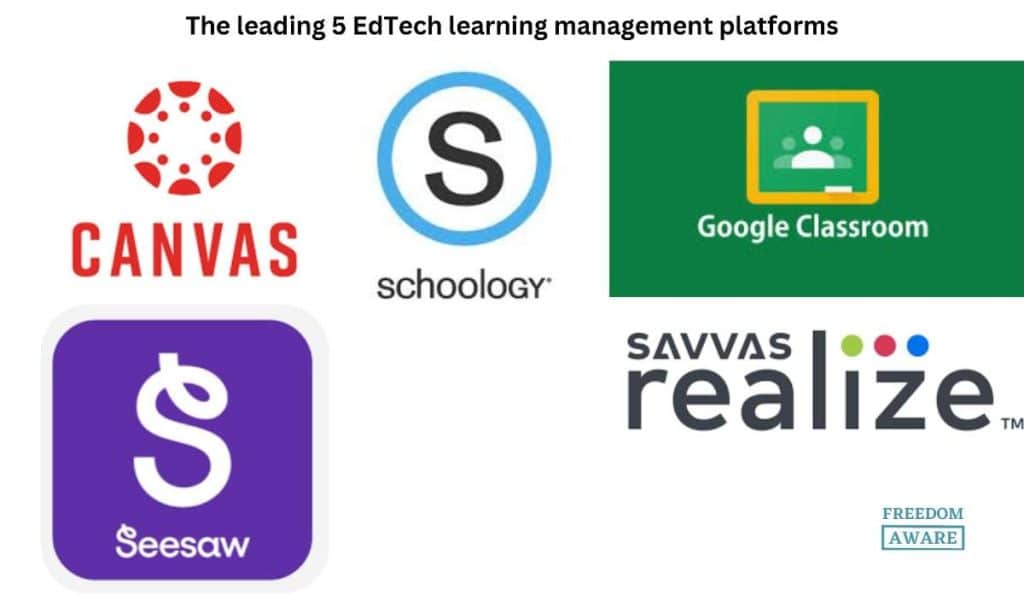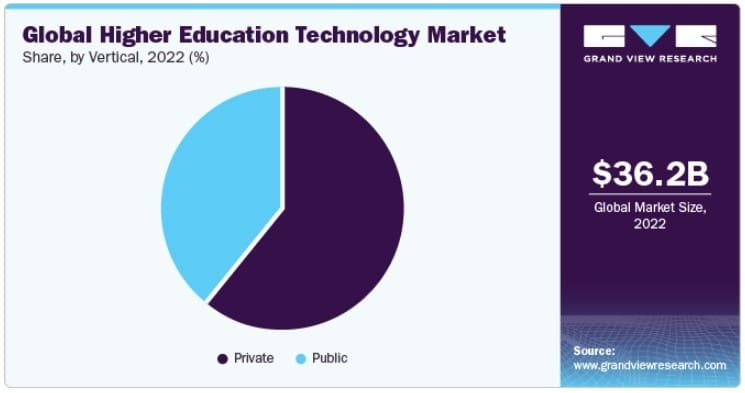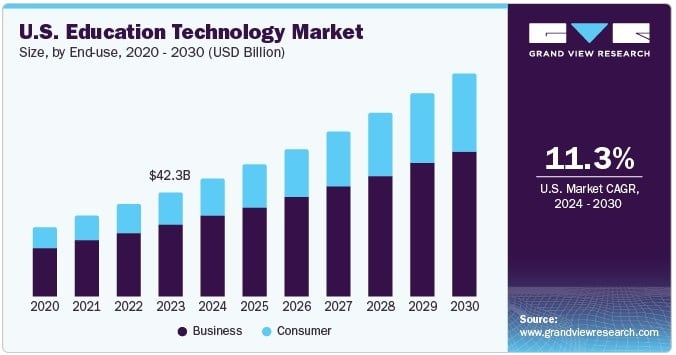
Explore the latest EdTech statistics and trends shaping the future of education.
The education technology (EdTech) industry has experienced unprecedented growth in recent years, transforming how we learn and teach. From online learning platforms to AI-powered adaptive learning tools, EdTech has revolutionized the education sector.
But what do the numbers say?
This article will delve into the latest EdTech statistics to comprehensively understand the industry’s current state and prospects.
Top EdTech Statistics (Editor’s Pick)
- The EdTech market is projected to reach $340 billion by 2023.
- Corporate EdTech is a $27.5 billion industry.
- EdTech usage in K-12 schools has increased by 99% since 2020.
- Over 70% of colleges expect to launch one or more online undergraduate programs in the next three years.
- 71% of online adults aged 18-29 use social media to learn about educational opportunities.
- Digital learning is the most popular corporate skill-building strategy.
- EdTech private investment is expected to return to $7-8 billion pre-pandemic.
- The global EdTech revenue hit $106 billion in 2021 and is predicted to grow 16.5% annually through 2030.
- The adaptive learning market is predicted to reach $9.11 billion by 2028.
- The projected demand for Generative AI in Edtech in North America, valued at USD 39.1 million in 2023, is anticipated to experience substantial growth from 2024 to 2033.
General EdTech Statistics
- The global corporate e-learning market, valued at $22.15 billion in 2023, is expected to reach $46.08 billion by 2030, growing at a compound annual growth rate (CAGR) of 10.9% from 2024 to 2030. (Source)
- The use of EdTech in K-12 schools has risen by 99% since 2020. (Source)
- A major obstacle in the educational technology market is the limited availability of reliable internet and digital devices, which hinders widespread adoption. (Source)
- In 2019, the consumer goods sector held the largest share of the corporate e-learning market at approximately 20%. (Source)
- Corporate e-learning is divided into two types – on-premise and cloud-based deployment, with cloud-based deployment being the main service form and accounting for approximately 79% of the market share in 2019. It is expected to continue to grow in the forecast period. (Source)
- The education market for augmented reality (AR) was valued at $5.3 billion in 2023, while revenues from Virtual Reality (VR) head-mounted displays (HMDs) in education were expected to exceed $640 million. (Source)

- The leading 5 EdTech learning management platforms are Google Classroom, Canvas, Schoology, Savvas Realize, and Seesaw. (Source)
- Quizlet, Desmos, and Grammarly are the most popular EdTech study tools among students and teachers. (Source)
- According to a survey by the EdWeek Research Center, 42% of educators reported that students had greater access to school-issued personal devices during the pandemic than before. However, 18% of these educators noted that this increased access was temporary and would end up on schools reopening. (Source)
- 58% of educators in a survey claimed their perception of Edtech had improved due to increased technology use during coronavirus school building closures. (Source)
- 93% of teachers were engaged in some form of online instruction during the pandemic, with 50% teaching exclusively online. This percentage varied significantly based on the districts’ income levels. (Source)
- Among district leaders and teachers, 6% of the former and 21% of the latter reported a more negative view of Edtech following experiences during coronavirus closures. (Source)
- During school closures, 87% of teachers reported improving their ability to use educational technologies, while only 3% reported a decline in their ed-tech skills. (Source)
- The global e-learning market is expected to reach nearly 400 billion U.S. dollars by 2026. (Source)
- Challenge-based gamification has been shown to increase student outcomes by up to 35% potentially. (Source)
- The global EdTech market is projected to reach US$231.08 billion by 2027, with a compound annual growth rate (CAGR) of 13.61% from 2022 to 2027. The hardware segment showed gradual market share growth from US$27.14 billion in 2017 to 2021. (Source)

- Worldwide spending on EdTech is expected to increase dramatically in several key segments in 2025. Expenditure on augmented and virtual reality is forecasted to increase from 1.6 billion US dollars in 2018 to 12.6 billion in 2025. (Source)
- The global edtech market is expected to grow from $108.246 billion in 2024 to $411.566 billion by 2034, representing a compound annual growth rate (CAGR) of 14.3% over the next decade. (Source)
- Worldwide spending on EdTech is expected to grow substantially, particularly in augmented and virtual reality, from US$1.6 billion in 2018 to US$12.6 billion in 2025. (Source)
K-12 EdTech Statistics
- The K-12 education technology market, valued at $1.6 billion in 2023, is expected to reach $8.8 billion by 2032, growing at a 21.3% CAGR from 2023 to 2032. (Source)
- The K-12 EdTech segment held the largest market share in 2023, exceeding 39%, driven by the increasing popularity of game-based learning in the K-12 sector. (Source)
- According to a 2022 report, K-12 EdTech engagement was focused 17.5% on organization, 22.5% on educators, and 66.0% on learners. (Source)
- During the 2022-23 school year, Google Classroom was the leading learning management system used by K-12 students and teachers in the United States. (Source)
- On average, US K-12 school districts access 1403 EdTech solutions each month. (Source)
Higher Education Technology Statistics (EdTech Statistics)
- Student information management systems dominated the higher EdTech market in 2022, capturing over 25% of the market share. Meanwhile, campus management is poised for significant growth, projected to expand at a CAGR exceeding 25% during the forecast period. (Source)
- Since the pandemic, 98% of universities have transitioned their classes to an online format. (Source)
- Additionally, professional services led the higher EdTech market with a 59% share and are expected to maintain dominance through 2030. Meanwhile, managed services are projected to grow at a CAGR of 20%, representing the fastest-growing segment in the forecast period. (Source)
- On-premise deployment led the higher EdTech market with a 54% share in 2022, but cloud deployment is expected to grow at a CAGR of over 20% and gain ground by 2030. (Source)
- For learning mode, offline learning led the higher EdTech market with a 53% share in 2022, but online learning is expected to grow at a CAGR of over 19% and gain ground by 2030. (Source)
- The private segment of the higher EdTech market held around 60% market share in 2022 and is expected to remain dominant by 2030, while the public segment is expected to experience significant growth at a 21% compound annual growth rate (CAGR) between 2023 and 2030. (Source)

- The global higher EdTech market was anticipated to be worth USD 36.24 billion in 2022, with a compound annual growth rate (CAGR) of 18.6% expected between 2023 and 2030. (Source)
Generative AI Educational Statistics (EdTech Statistics)
- Educational institutions utilizing Generative AI for content creation and course development saw a 25% reduction in time and costs in 2023. (Source)
- In 2023, 45% of educational institutions were exploring the use of Generative AI for administrative tasks such as scheduling and resource management. (Source)
- The application of Generative AI to make learning interactive through gamification in EdTech saw a 20% increase in 2023, enhancing student engagement. (Source)
- Analysts anticipate that by the end of 2024, over 60% of major EdTech companies will have incorporated Generative AI into their offerings, driving innovation and personalized learning. (Source)
- The demand for Generative AI in Edtech in North America was estimated at USD 39.1 million in 2023 and is expected to expand considerably from 2024 to 2033. (Source)
- Students accounted for more than 49% of the market share in the Generative AI in the EdTech market in 2023, highlighting the impact of these technologies on enhancing the student learning experience. (Source)
- In 2023, the use of Generative AI for language learning and translation in EdTech increased by 18%, making language learning more effective and engaging. (Source)
- The adoption of Generative AI for grading and assessment in EdTech solutions increased by 15% in 2023, streamlining educators’ workloads. (Source)
- The integration of Generative AI in virtual and augmented reality (VR/AR) for learning purposes increased by 22% in 2023, offering immersive educational experiences. (Source)
- Experts predict that using Generative AI for personalized career advice and skill-building in EdTech will grow by 28% by the end of 2024. (Source)
- In 2023, Adaptive Learning dominated the Generative AI in the EdTech market with a 39% share due to its ability to personalize learning experiences tailored to individual learners’ needs, pace, and preferences. (Source)

- The global generative AI in the EdTech market is expected to grow from $268M in 2023 to $8.3B by 2033, at a 41% CAGR from 2024 to 2033. (Source)
- The use of Generative AI for language translation and accessibility features in EdTech solutions grew by 18% in 2023, promoting inclusivity in education. (Source)
- The adoption of Generative AI for personalized learning and adaptive tutoring in EdTech increased by 32% in 2023, with 50% of organizations increasing their investments in these technologies. (Source)
- The market size for Generative AI is expected to grow from USD 13.5 billion in 2023 to approximately USD 255.8 billion by 2033, with an annual growth rate of 34.2%. (Source)
EdTech Statistics by Country
- In 2022, there were 14 EdTech funding deals in Indonesia, up from 11 the previous year. This covered various sectors, including digital certification, vocational skills, linguistic courses, learning management systems (LMS), K-12 learning, student loans, and children’s productivity platforms. (Source)
- In 2023, 47% of the leading 50 Southeast Asian EdTech startups were based in Singapore, while Indonesia’s share decreased from 35% in 2020 to 20% in 2023. (Source)
- As of 2022, EdTech funding in Indonesia totaled approximately US $18 million, marking an increase from the previous year. This indicated a rise of about $6.65 million from 2021 to 2022. (Source)
- According to the Research Institute of America, e-learning can increase staff retention rates by 25% to 60% in businesses. (Source)
- As of 2022, the penetration rate of online university education in Indonesia was approximately 0.3%. (Source)

- The U.S. EdTech market is projected to grow at a compound annual growth rate (CAGR) of 11.3% between 2024 and 2030. The abundance of startups and established EdTech companies in the country is driving this growth. (Source)
- Australia and New Zealand are anticipated to experience significant growth in the EdTech market, with a projected CAGR of 22.7% from 2024 to 2034. (Source)
- As of January 2023, ByJu, an Indian company, held the highest valuation among EdTech unicorns worldwide at US $22 billion. Among the top ten companies by valuation, five were from the United States, two were from India, and Austria and Canada each had one EdTech unicorn. (Source)
- In 2020, the Kindergarten to twelfth-grade education market was valued at US$1.16 billion, while the skill development market was valued at less than US $500 million. The market is anticipated to remain the largest segment, followed by test preparation and online certification. (Source)
- Skyeng led the revenue among EdTech platforms in Russia, generating 7.4 billion Russian rubles from July to September 2023. Skillbox Holding Limited followed with 3.5 billion Russian rubles in revenue, which includes brands like Skillbox, GeekBrains, and SkillFactory. (Source)
- Online university courses had the highest revenue among different levels of digital education in Russia, reaching 15 billion Russian rubles in 2021. In the same year, online secondary education services were valued at 10 billion Russian rubles. (Source)
- North America is expected to contribute 41% to the global EdTech market growth during the forecast period. (Source)
Conclusion (EdTech Statistics)
As data reveals trends in student engagement, digital tool adoption, and personalized learning, it is clear that EdTech is not merely an enhancement but a fundamental component of modern education. Educators and institutions that harness these insights can tailor their approaches to meet the diverse needs of learners, thereby unlocking new pathways for educational success. As we continue to navigate the evolving landscape of education technology, staying informed about these statistics will be essential for making data-driven decisions that promote effective learning environments and prepare students for a future where technology and education are deeply intertwined.


Leave a Reply